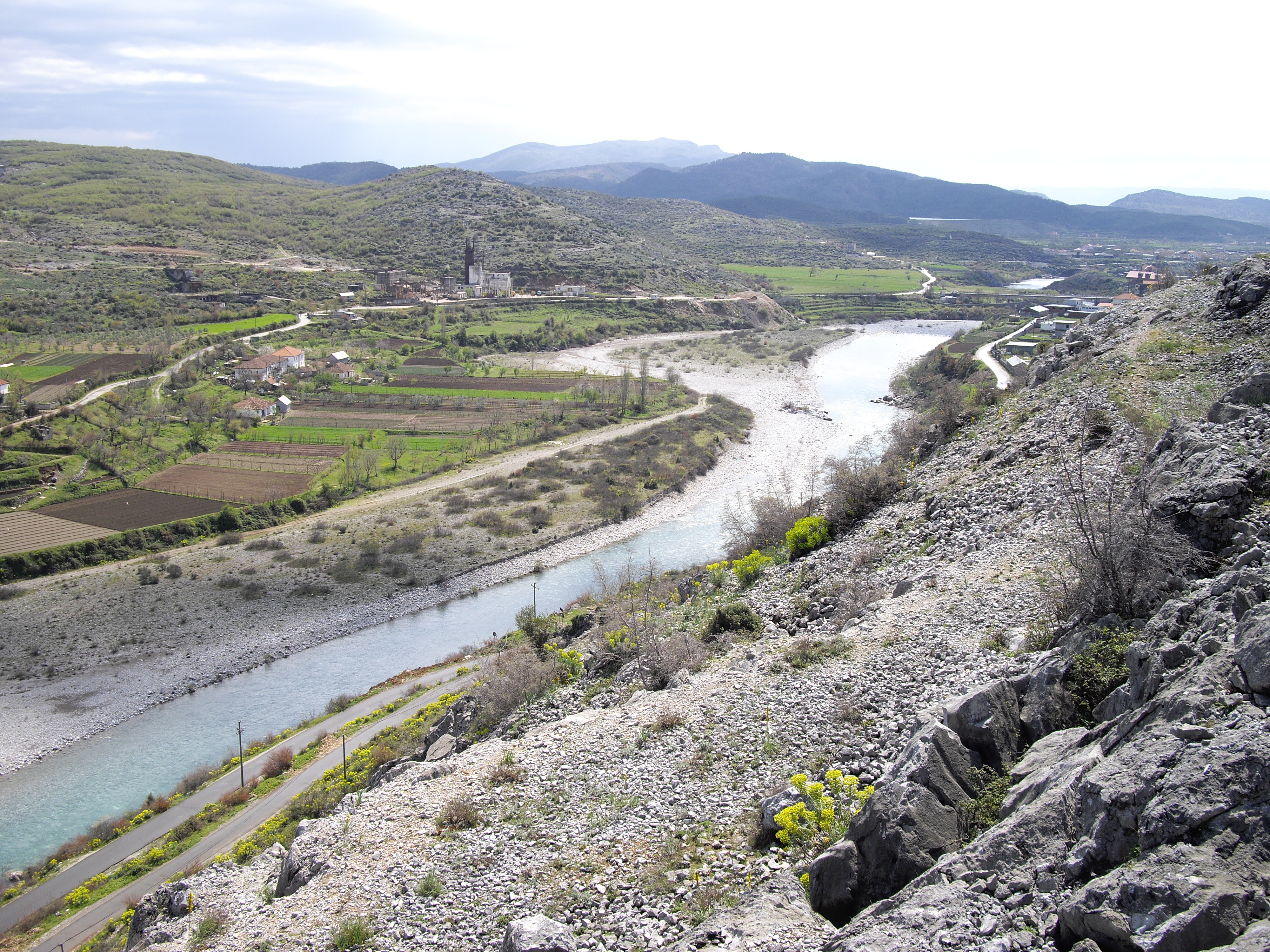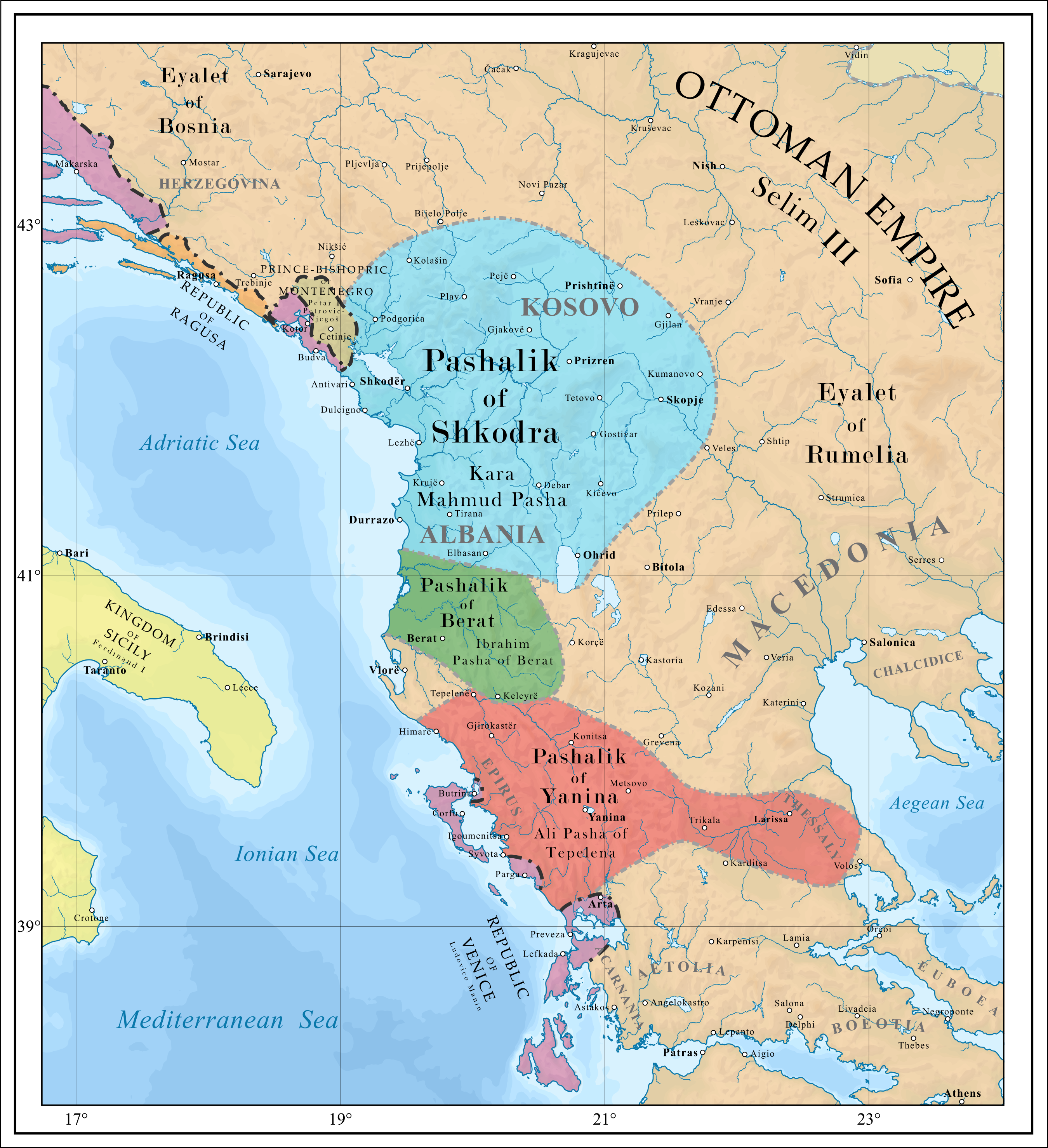|
Mesi Bridge
Mesi Bridge ( sq, Ura e Mesit "The bridge in the middle") is a bridge in the village of Mes, about (as the crow flies) northeast of Shkodër, in northwestern Albania. It is a monument of Postribë culture, turning the site into a tourist attraction with a lot of visitors from all around the world. For foreigners the architecture of the bridge is intriguing with round slick stones and stone plates. The surrounding panorama gives the bridge an even more picturesque view. The Albanian Development Fund invested 13 million lekë so the tourists could step on the bridge and watch it closely because there was no entry way to the bridge. It was built in the 18th century, around 1770, by Kara Mahmud Bushati, the local Ottoman pasha, and spans the Kir River. The building was divided in 2 phases where the first phase was only the middle arc and the arc near it and the second phase included the other 11 arches. The purpose was to connect the city of Shkodër with the city of Drisht and othe ... [...More Info...] [...Related Items...] OR: [Wikipedia] [Google] [Baidu] |
Kir River
The Kir ( sq, Kir or ''Kiri'') is a river in northern Albania that first flows south-southwest and then southwest out of the North Albanian Alps and enters a distributary of the Drin just below Shkodër. In the upper reaches the river cuts the "Canyon of the Kir" with dramatic cliffs.The Albanian tribe or ''fis'' of Kiri inhabited this area. Just outside Shkodër, in Mes, the old stone Mes Bridge Mesi Bridge ( sq, Ura e Mesit "The bridge in the middle") is a bridge in the village of Mes, about (as the crow flies) northeast of Shkodër, in northwestern Albania. It is a monument of Postribë culture, turning the site into a tourist attract ... crosses the Kir. Notes External links *Static image*Static image Rivers of Albania Geography of Shkodër County {{Albania-river-stub ... [...More Info...] [...Related Items...] OR: [Wikipedia] [Google] [Baidu] |
Drisht
Drisht ( sq-definite, Drishti) is a village, former bishopric and Latin titular see with an Ancient and notable medieval history (Latin ''Drivastum,'' Italian ''Drivasto'') in Albania, 6 km from Mes Bridge (Albanian: ''Ura e Mesit''). It is located in the former municipality Postribë in the Shkodër County. At the 2015 local government reform it became part of the municipality Shkodër. The ruined 13th Century Drisht Castle is on a hilltop 300m above sea level. The ruins of the castle itself contains the remains of 11 houses, and below the ruins of the castle, and above the modern village of Drisht are further archeological remains of late-Roman and medieval Drivastum. Name The name of the settlement was recorded in Latin as ''Drivastum''. Albanian ''Drisht'' derives from ''Drivastum'' through Albanian phonetic changes, however it has been noted that the accentual pattern found in ''Drísht'' < ''Drívastum'' presupposes an Adriatic " [...More Info...] [...Related Items...] OR: [Wikipedia] [Google] [Baidu] |
Pedestrian Bridges In Albania
A pedestrian is a person traveling on foot, whether walking or running. In modern times, the term usually refers to someone walking on a road or pavement, but this was not the case historically. The meaning of pedestrian is displayed with the morphemes ''ped-'' ('foot') and ''-ian'' ('characteristic of'). This word is derived from the Latin term ''pedester'' ('going on foot') and was first used (in English language) during the 18th century. It was originally used, and can still be used today, as an adjective meaning plain or dull. However, in this article it takes on its noun form and refers to someone who walks. The word pedestrian may have been used in middle French in the Recueil des Croniques et Anchiennes Istories de la Grant Bretaigne, à présent nommé Engleterre. In California the definition of a pedestrian has been broadened to include anyone on any human powered vehicle that is not a bicycle, as well as people operating self-propelled wheelchairs by reason of ph ... [...More Info...] [...Related Items...] OR: [Wikipedia] [Google] [Baidu] |
Tourist Attractions In Shkodër
Tourism is travel for pleasure or business; also the theory and practice of touring (other), touring, the business of attracting, accommodating, and entertaining tourists, and the business of operating tour (other), tours. The World Tourism Organization defines tourism more generally, in terms which go "beyond the common perception of tourism as being limited to holiday activity only", as people "travelling to and staying in places outside their usual environment for not more than one consecutive year for leisure and not less than 24 hours, business and other purposes". Tourism can be Domestic tourism, domestic (within the traveller's own country) or International tourism, international, and international tourism has both incoming and outgoing implications on a country's balance of payments. Tourism numbers declined as a result of a strong economic slowdown (the late-2000s recession) between the second half of 2008 and the end of 2009, and in consequence of t ... [...More Info...] [...Related Items...] OR: [Wikipedia] [Google] [Baidu] |
Buildings And Structures In Shkodër
A building, or edifice, is an enclosed structure with a roof and walls standing more or less permanently in one place, such as a house or factory (although there's also portable buildings). Buildings come in a variety of sizes, shapes, and functions, and have been adapted throughout history for a wide number of factors, from building materials available, to weather conditions, land prices, ground conditions, specific uses, prestige, and aesthetic reasons. To better understand the term ''building'' compare the list of nonbuilding structures. Buildings serve several societal needs – primarily as shelter from weather, security, living space, privacy, to store belongings, and to comfortably live and work. A building as a shelter represents a physical division of the human habitat (a place of comfort and safety) and the ''outside'' (a place that at times may be harsh and harmful). Ever since the first cave paintings, buildings have also become objects or canvasses of much artistic ... [...More Info...] [...Related Items...] OR: [Wikipedia] [Google] [Baidu] |
Ottoman Bridges In Albania
Ottoman is the Turkish spelling of the Arabic masculine given name Uthman ( ar, عُثْمان, ‘uthmān). It may refer to: Governments and dynasties * Ottoman Caliphate, an Islamic caliphate from 1517 to 1924 * Ottoman Empire, in existence from 1299 to 1922 ** Ottoman dynasty, ruling family of the Ottoman Empire *** Osmanoğlu family, modern members of the family * Ottoman architecture Ethnicities and languages * Ottoman Armenians, the Armenian ethnic group in the Ottoman Empire * Ottoman Greeks, the Greek ethnic group in the Ottoman Empire * Ottoman Serbs, the Serbian ethnic group in the Ottoman Empire * Ottoman Turks, the Turkic ethnic group in the Ottoman Empire ** Ottoman Turkish alphabet ** Ottoman Turkish language, the variety of the Turkish language that was used in the Ottoman Empire Products * Ottoman bed, a type of storage bed * Ottoman (furniture), padded stool or footstool * Ottoman (textile), fabric with a pronounced ribbed or corded effect, often made of sil ... [...More Info...] [...Related Items...] OR: [Wikipedia] [Google] [Baidu] |
Bridges Completed In 1770
A bridge is a structure built to span a physical obstacle (such as a body of water, valley, road, or rail) without blocking the way underneath. It is constructed for the purpose of providing passage over the obstacle, which is usually something that is otherwise difficult or impossible to cross. There are many different designs of bridges, each serving a particular purpose and applicable to different situations. Designs of bridges vary depending on factors such as the function of the bridge, the nature of the terrain where the bridge is constructed and anchored, and the material used to make it, and the funds available to build it. The earliest bridges were likely made with fallen trees and stepping stones. The Neolithic people built boardwalk bridges across marshland. The Arkadiko Bridge (dating from the 13th century BC, in the Peloponnese) is one of the oldest arch bridges still in existence and use. Etymology The '' Oxford English Dictionary'' traces the origin of ... [...More Info...] [...Related Items...] OR: [Wikipedia] [Google] [Baidu] |
Pristina
Pristina, ; sr, / (, ) is the capital and largest city of Kosovo. The city's municipal boundaries in Pristina District form the largest urban center in Kosovo. After Tirana, Pristina has the second largest population of ethnic Albanians and speakers of the Albanian language. Inhabited by humans since prehistoric times, the area of Pristina was home to several Illyrian peoples. King Bardyllis of the Dardanians brought various tribes together in the 4th century BC and established the Dardanian Kingdom.''The Cambridge Ancient History: The fourth century B.C.'' Volume 6 of The Cambridge Ancient History Iorwerth Eiddon Stephen Edwards, , , Authors: D. M. Lewis, John Boardman, Editors: D. M. Lewis, John Boardman, Second Edition, Cambridge ... [...More Info...] [...Related Items...] OR: [Wikipedia] [Google] [Baidu] |
Pasha
Pasha, Pacha or Paşa ( ota, پاشا; tr, paşa; sq, Pashë; ar, باشا), in older works sometimes anglicized as bashaw, was a higher rank in the Ottoman Empire, Ottoman political and military system, typically granted to governors, generals, dignitary, dignitaries, and others. As an honorific, honorary title, ''Pasha'', in one of its various ranks, is similar to a British Peerage of the United Kingdom, peerage or knighthood, and was also one of the highest titles in the 20th-century Kingdom of Egypt. The title was also used in Morocco in the 20th century, where it denoted a regional official or governor of a district. Etymology The English word "pasha" comes from Turkish language, Turkish ('; also ()). The Oxford Dictionaries (website), Oxford Dictionaries attributes the origin of the English borrowing to the mid-17th century. The etymology of the Turkish word itself has been a matter of debate. Contrary to titles like emir (''amīr'') and bey (''beg''), which were es ... [...More Info...] [...Related Items...] OR: [Wikipedia] [Google] [Baidu] |
Ottoman Empire
The Ottoman Empire, * ; is an archaic version. The definite article forms and were synonymous * and el, Оθωμανική Αυτοκρατορία, Othōmanikē Avtokratoria, label=none * info page on book at Martin Luther University) // CITED: p. 36 (PDF p. 38/338) also known as the Turkish Empire, was an empire that controlled much of Southeast Europe, Western Asia, and Northern Africa between the 14th and early 20th centuries. It was founded at the end of the 13th century in northwestern Anatolia in the town of Söğüt (modern-day Bilecik Province) by the Turkoman tribal leader Osman I. After 1354, the Ottomans crossed into Europe and, with the conquest of the Balkans, the Ottoman beylik was transformed into a transcontinental empire. The Ottomans ended the Byzantine Empire with the conquest of Constantinople in 1453 by Mehmed the Conqueror. Under the reign of Suleiman the Magnificent, the Ottoman Empire marked the peak of its power and prosperity, as well a ... [...More Info...] [...Related Items...] OR: [Wikipedia] [Google] [Baidu] |
Kara Mahmud Bushati
Kara Mahmud Pasha ( tr, Kara Mahmud Paşa, Albanian: Mahmud Pashë Bushati, 1749–22 September 1796) was a hereditary Ottoman Albanian governor ('' mutasarrıf'') of the Pashalik of Scutari and de jure ruler of Albania, belonging to the Ottoman Albanian Bushati family. Life Mahmud was the son of Mehmed Pasha Bushati, the governor of the pashalik of Scutari. When Mehmed Pasha died in June 1775, the Sultan's rule was not returned to northern Albania; he was succeeded by his young son, Mahmud Pasha. Other important families were the Rotul dynasty, which ruled Prizren from the 1770s to 1836, and the Gjinolli family whose members ruled Prishtina and Gjilan (Srb.: Gnjil-ane), becoming so powerful in the early nineteenth century that they were called the 'second rulers' of Kosovo after the Sultan. In the late eighteenth century, however, there was just one local dynasty that could rival - and did in fact openly challenge - the Sultan: the Bushati or Bushatli family of Shkodra. ... [...More Info...] [...Related Items...] OR: [Wikipedia] [Google] [Baidu] |




